小学英语语法总结:动词的语态素材
- 格式:docx
- 大小:22.43 KB
- 文档页数:5
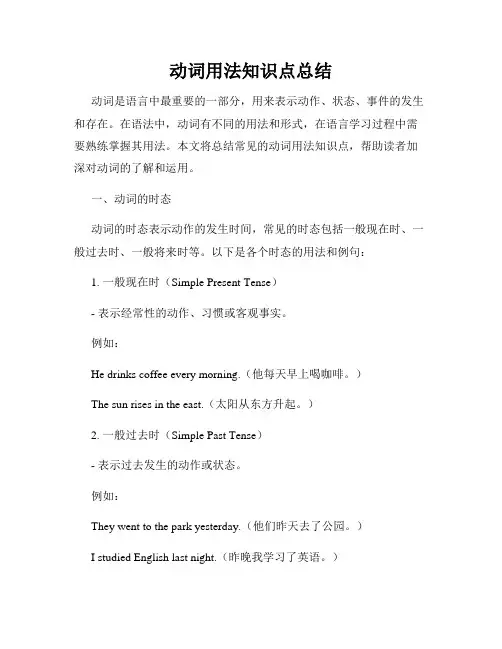
动词用法知识点总结动词是语言中最重要的一部分,用来表示动作、状态、事件的发生和存在。
在语法中,动词有不同的用法和形式,在语言学习过程中需要熟练掌握其用法。
本文将总结常见的动词用法知识点,帮助读者加深对动词的了解和运用。
一、动词的时态动词的时态表示动作的发生时间,常见的时态包括一般现在时、一般过去时、一般将来时等。
以下是各个时态的用法和例句:1. 一般现在时(Simple Present Tense)- 表示经常性的动作、习惯或客观事实。
例如:He drinks coffee every morning.(他每天早上喝咖啡。
)The sun rises in the east.(太阳从东方升起。
)2. 一般过去时(Simple Past Tense)- 表示过去发生的动作或状态。
例如:They went to the park yesterday.(他们昨天去了公园。
)I studied English last night.(昨晚我学习了英语。
)3. 一般将来时(Simple Future Tense)- 表示将来要发生的动作或计划。
例如:She will travel to Japan next month.(她下个月要去日本旅行。
)We are going to have a party this weekend.(我们本周末要举办聚会。
)4. 现在进行时(Present Continuous Tense)- 表示正在进行的动作。
例如:I am reading a book now.(我正在读一本书。
)They are playing basketball in the park.(他们正在公园打篮球。
)5. 过去进行时(Past Continuous Tense)- 表示过去某个时间点正在进行的动作。
例如:I was watching TV when he called me.(他给我打电话时,我正在看电视。
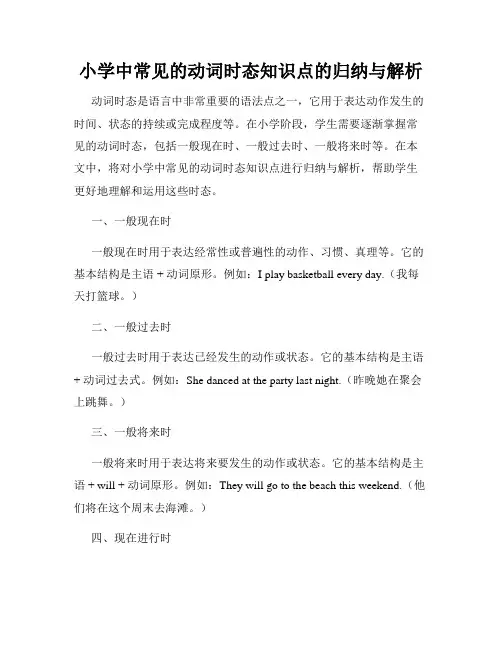
小学中常见的动词时态知识点的归纳与解析动词时态是语言中非常重要的语法点之一,它用于表达动作发生的时间、状态的持续或完成程度等。
在小学阶段,学生需要逐渐掌握常见的动词时态,包括一般现在时、一般过去时、一般将来时等。
在本文中,将对小学中常见的动词时态知识点进行归纳与解析,帮助学生更好地理解和运用这些时态。
一、一般现在时一般现在时用于表达经常性或普遍性的动作、习惯、真理等。
它的基本结构是主语 + 动词原形。
例如:I play basketball every day.(我每天打篮球。
)二、一般过去时一般过去时用于表达已经发生的动作或状态。
它的基本结构是主语+ 动词过去式。
例如:She danced at the party last night.(昨晚她在聚会上跳舞。
)三、一般将来时一般将来时用于表达将来要发生的动作或状态。
它的基本结构是主语 + will + 动词原形。
例如:They will go to the beach this weekend.(他们将在这个周末去海滩。
)四、现在进行时现在进行时用于表达现在正在进行的动作。
它的基本结构是主语 + am/is/are + 动词ing形式。
例如:We are watching a movie now.(我们现在正在看电影。
)五、过去进行时过去进行时用于表达过去某一时间段内正在进行的动作。
它的基本结构是主语 + was/were + 动词ing形式。
例如:They were talking on the phone when I arrived.(当我到达时,他们正在打电话。
)六、一般过去将来时一般过去将来时用于表示过去某个时间点本来想要发生的动作,但实际上并没有发生。
它的基本结构是主语 + was/were going to + 动词原形。
例如:I was going to call you yesterday, but I forgot.(昨天我本来想给你打电话,但是我忘了。
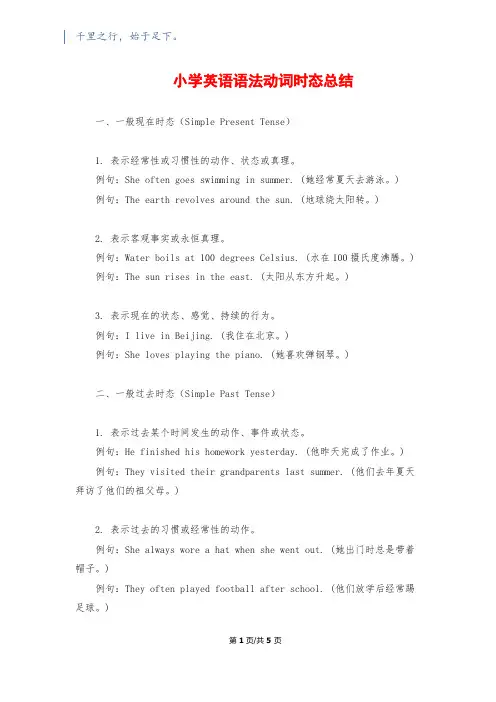
小学英语语法动词时态总结一、一般现在时态(Simple Present Tense)1. 表示经常性或习惯性的动作、状态或真理。
例句:She often goes swimming in summer. (她经常夏天去游泳。
)例句:The earth revolves around the sun. (地球绕太阳转。
)2. 表示客观事实或永恒真理。
例句:Water boils at 100 degrees Celsius. (水在100摄氏度沸腾。
) 例句:The sun rises in the east. (太阳从东方升起。
)3. 表示现在的状态、感觉、持续的行为。
例句:I live in Beijing. (我住在北京。
)例句:She loves playing the piano. (她喜欢弹钢琴。
)二、一般过去时态(Simple Past Tense)1. 表示过去某个时间发生的动作、事件或状态。
例句:He finished his homework yesterday. (他昨天完成了作业。
) 例句:They visited their grandparents last summer. (他们去年夏天拜访了他们的祖父母。
)2. 表示过去的习惯或经常性的动作。
例句:She always wore a hat when she went out. (她出门时总是带着帽子。
)例句:They often played football after school. (他们放学后经常踢足球。
)第1页/共5页3. 表示过去的真理或现状。
例句:He thought the earth was flat. (他认为地球是平的。
)例句:The dinosaurs became extinct millions of years ago. (恐龙在几百万年前灭绝了。
)三、一般将来时态(Simple Future Tense)1. 表示将要发生的动作或事件。

小学英语语法:动词的语态动词的语态语态有两种:主动语态和被动语态。
主语是动作的发出者为主动语态;主语是动作的接受者为被动语态。
1)若宾语补足语是不带to 的不定式,变为被动语态时,该不定式前要加"to"。
此类动词为感官动词。
feel, hear, help, listen to, look at, mak英语e, observe, see, notice, watchThe teacher made me go out of the classroom.--> I was made to go out of the classroom (by the teacher).We saw him play football on the playground.--> He was seen to play football on the playground.2)情态动词+ be +过去分词,构成被动语态。
Coal can be used to produce electricity for agriculture and industry.12.1 let 的用法1)当let后只有一个单音节动词,变被动语态时,可用不带to 的不定式。
They let the strange go.---> The strange was let go.2) 若let 后宾补较长时,let 通常不用被动语态,而用allow或permit 代替。
The nurse let me go to see my classmate in the hospital. ----> I was allowed / permitted to see my classmate in the hospital.12.2 短语动词的被动语态短语动词是一个整体,不可丢掉后面的介词或副词。
This is a photo of the power station that has been set up in my hometown.My sister will be taken care of by Grandma.Such a thing has never been heard of before..12.3 表示"据说"或"相信" 的词组believe, consider, declare, expect, feel , report, say, see, suppose, think, understand It is said that…据说It is reported that… 据报道It is believed that…大家相信It is hoped that…大家希望It is well known that… 众所周知It is thought that…大家认为It is suggested that…据建议It is taken granted that…被视为当然It has been decided that… 大家决定It must be remember that…务必记住的是It is said that she will leave for Wuhan on Tuesday.12.4 不用被动语态的情况1) 不及物动词或动词短语无被动语态:appear, die disappear, end (vi. 结束), fail, happen, last, lie, remain, sit, spread, stand break out, come true, fall asleep, keep silence, lose heart, take place.After the fire, very little remained of my house.比较: rise, fall, happen是不及物动词;raise, seat是及物动词。

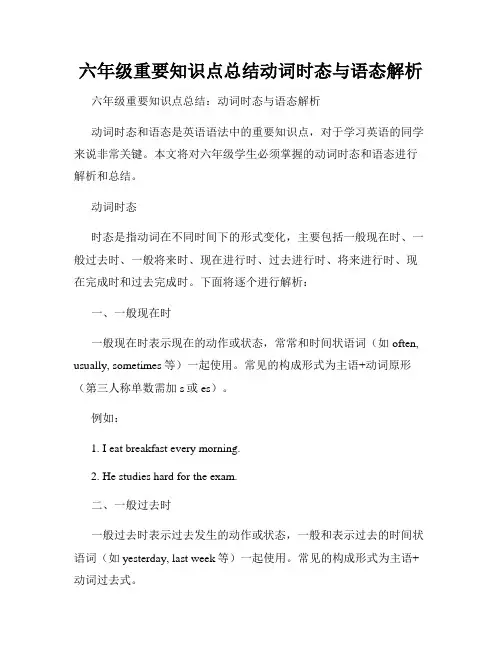
六年级重要知识点总结动词时态与语态解析六年级重要知识点总结:动词时态与语态解析动词时态和语态是英语语法中的重要知识点,对于学习英语的同学来说非常关键。
本文将对六年级学生必须掌握的动词时态和语态进行解析和总结。
动词时态时态是指动词在不同时间下的形式变化,主要包括一般现在时、一般过去时、一般将来时、现在进行时、过去进行时、将来进行时、现在完成时和过去完成时。
下面将逐个进行解析:一、一般现在时一般现在时表示现在的动作或状态,常常和时间状语词(如often, usually, sometimes等)一起使用。
常见的构成形式为主语+动词原形(第三人称单数需加s或es)。
例如:1. I eat breakfast every morning.2. He studies hard for the exam.二、一般过去时一般过去时表示过去发生的动作或状态,一般和表示过去的时间状语词(如yesterday, last week等)一起使用。
常见的构成形式为主语+动词过去式。
例如:1. She played soccer yesterday.2. We went to the park last Sunday.三、一般将来时一般将来时表示将来要发生的动作或状态,一般和表示将来的时间状语词(如tomorrow, next month等)一起使用。
常见的构成形式为主语+will+动词原形。
例如:1. They will visit their grandparents tomorrow.2. I will study for the test next week.四、现在进行时现在进行时表示现在正在进行的动作,常与现在进行时标志词(如now, at the moment等)一起使用。
常见的构成形式为主语+am/is/are+动词-ing形式。
例如:1. We are watching a movie now.2. She is playing the piano at the moment.五、过去进行时过去进行时表示过去某一时刻正在进行的动作,一般和过去进行时标志词(如at that time, at 3 o'clock等)一起使用。

英语语法:动词的时态和语态语态和时态学习英语的两大基础,是构成英语句型的关键,掌握了它们就为学好英语打下了坚实的基础。
所以用时必须熟练而准确。
小编在这里整理了相关知识,快来学习学习吧!一、一般现在时1、表示经常发生的习惯性的、现在反复出现的动作或状态,常用的时间状语有:always,usually,seldom, sometimes, every day, now and then, once a week 等。
2、表示眼下或目前等现在时间所发生的动作或存在的状态,这种状态带有一定的持续性。
3、表示客观事实或普遍真理。
4、书报的标题,故事的叙述,小说、戏剧、电影等情节介绍,图片的说明。
5、时间表、时刻表、日程表、节目单、课程表等按规定将要发生的动作,只限于 go, arrive, leave, start, stay, return, begin, come 等动词。
6、在时间、条件、方式、让步状语从句中,表示将来的动作。
注意:一般现在时可以用于定语从句或宾语从句中表示将来。
7、用在某些表达中,表示现在正在发生的动作或存在的状态。
Here comes the bus!How it rains!二、一般过去时等1、表示在过去某一时间点发生的动作或所处的状态,与现在没有关系。
常用的时间状语有:yesterday, last night, at that time 等。
2、表示在过去某一段时间里反复出现的动作或状态,与现在没有关系。
3、用 used to do 或would do 表示过去经常或反复发生的动作。
4、有些情况发生的时间没清楚表明,但实际上是“刚才,刚刚”发生的,属于过去时间,应使用过去时态。
常见的有 I didn’t know…或 I forgot…等。
5、一般过去时可与 today, this week, this month 等时间状语连用。
三、一般将来时1、will/shall do(1)表示将来会出现的动作或状态。
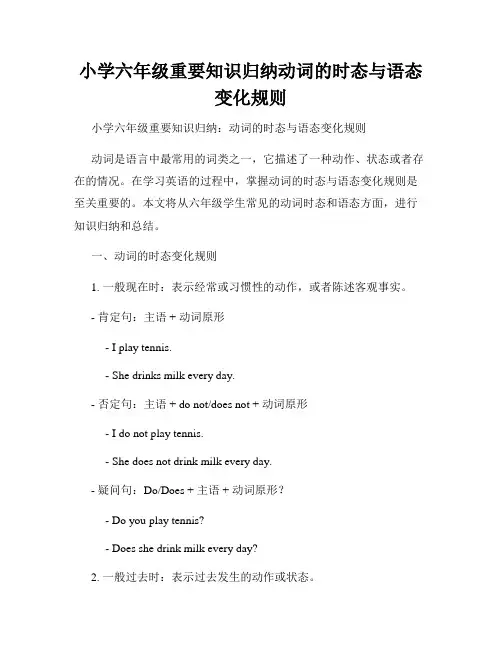
小学六年级重要知识归纳动词的时态与语态变化规则小学六年级重要知识归纳:动词的时态与语态变化规则动词是语言中最常用的词类之一,它描述了一种动作、状态或者存在的情况。
在学习英语的过程中,掌握动词的时态与语态变化规则是至关重要的。
本文将从六年级学生常见的动词时态和语态方面,进行知识归纳和总结。
一、动词的时态变化规则1. 一般现在时:表示经常或习惯性的动作,或者陈述客观事实。
- 肯定句:主语 + 动词原形- I play tennis.- She drinks milk every day.- 否定句:主语 + do not/does not + 动词原形- I do not play tennis.- She does not drink milk every day.- 疑问句:Do/Does + 主语 + 动词原形?- Do you play tennis?- Does she drink milk every day?2. 一般过去时:表示过去发生的动作或状态。
- 肯定句:主语 + 动词过去式- I played tennis yesterday.- She drank milk this morning.- 否定句:主语 + did not + 动词原形- I did not play tennis yesterday.- She did not drink milk this morning.- 疑问句:Did + 主语 + 动词原形?- Did you play tennis yesterday?- Did she drink milk this morning?3. 现在进行时:表示现在正在进行的动作。
- 肯定句:主语 + am/is/are + 动词-ing- I am playing tennis now.- She is drinking milk at the moment.- 否定句:主语 + am not/is not/are not + 动词-ing - I am not playing tennis now.- She is not drinking milk at the moment.- 疑问句:Am/Is/Are + 主语 + 动词-ing?- Are you playing tennis now?- Is she drinking milk at the moment?4. 过去进行时:表示过去某个时间段正在进行的动作。

小学四年级动词时态和语态用法梳理动词在英语中起着非常重要的作用,它们不仅代表了动作、状态和行为,还能帮助我们表达时间、语态和语气等。
在小学四年级的学习中,我们会接触到一些基础的动词时态和语态,本文将对它们进行梳理。
一、动词的时态用法1. 一般现在时:表示经常性的、习惯性的或普遍性的事实,也可用于客观叙述。
例句:I play football every afternoon.They often go to the park on weekends.2. 一般过去时:表示过去发生的动作或状态。
例句:We visited the zoo last week.She played the piano when she was five.3. 一般将来时:表示将来会发生的动作或状态。
例句:I will have a party next Saturday.They are going to visit their grandparents tomorrow.4. 现在进行时:表示现在正在进行的动作。
例句:He is reading a book at the moment.They are playing in the garden now.5. 过去进行时:表示过去某一时刻正在进行的动作。
例句:They were watching a movie when I called them.She was cooking dinner at that time yesterday.6. 将来进行时:表示将来某一时刻正在进行的动作。
例句:I will be studying for my exam this time tomorrow.They will be having a meeting at 3 o'clock this afternoon.7. 现在完成时:表示过去某一时刻开始,并一直持续到现在的动作或状态。

知识点二年级动词时态知识点总结动词时态是指动词在不同时间下所表示的状态或动作的形式。
在二年级学习英语时,学习动词时态是一个重要的语法知识点。
本文将对二年级学生需要掌握的动词时态知识进行总结,帮助他们更好地理解和运用。
一、一般现在时(Simple Present)一般现在时表示经常性的动作、习惯、真理或客观事实。
1. 形式:主语 + 动词原形(第三人称单数加-s)2. 例句:- I play with my friends every day.(我每天和朋友们一起玩。
)- He likes to eat apples.(他喜欢吃苹果。
)- Water boils at 100 degrees Celsius.(水在100摄氏度沸腾。
)二、一般过去时(Simple Past)一般过去时表示过去发生的动作或状态。
1. 形式:主语 + 动词过去式2. 例句:- We visited the zoo last week.(我们上星期参观了动物园。
)- She watched a movie yesterday.(她昨天看了一部电影。
)- They played soccer in the park.(他们在公园里踢足球。
)三、将来时态(Future Tense)将来时态表示将来要发生的动作或状态。
1. 形式:- 主语 + will + 动词原形(表示预测、意愿或承诺的未来动作)- 主语 + be going to + 动词原形(表示计划、打算或预测的未来动作)2. 例句:- They will go to the beach this weekend.(他们将在这个周末去海滩。
)- I am going to study hard for the exam.(我打算好好备考。
)- He will be a doctor in the future.(他将来会成为一名医生。
)四、现在进行时(Present Continuous)现在进行时表示正在进行的动作,也可用来表示将来安排好的近期动作。
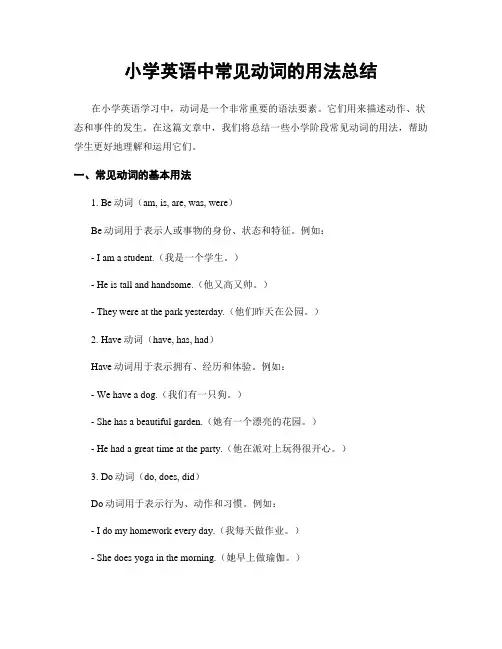
小学英语中常见动词的用法总结在小学英语学习中,动词是一个非常重要的语法要素。
它们用来描述动作、状态和事件的发生。
在这篇文章中,我们将总结一些小学阶段常见动词的用法,帮助学生更好地理解和运用它们。
一、常见动词的基本用法1. Be动词(am, is, are, was, were)Be动词用于表示人或事物的身份、状态和特征。
例如:- I am a student.(我是一个学生。
)- He is tall and handsome.(他又高又帅。
)- They were at the park yesterday.(他们昨天在公园。
)2. Have动词(have, has, had)Have动词用于表示拥有、经历和体验。
例如:- We have a dog.(我们有一只狗。
)- She has a beautiful garden.(她有一个漂亮的花园。
)- He had a great time at the party.(他在派对上玩得很开心。
)3. Do动词(do, does, did)Do动词用于表示行为、动作和习惯。
例如:- I do my homework every day.(我每天做作业。
)- She does yoga in the morning.(她早上做瑜伽。
)- They did their best in the competition.(他们在比赛中尽力了。
)4. Go动词(go, goes, went)Go动词用于表示移动和前往某个地方。
例如:- We go to school by bus.(我们坐公交车去学校。
)- He goes to the library every Saturday.(他每个星期六去图书馆。
)- They went to the beach last summer.(他们去年夏天去海滩。
)二、常见动词的时态和语态用法1. 一般现在时一般现在时表示经常性或习惯性的动作。
小学五年级重要知识总结动词的时态与语态形式与用法五年级重要知识总结:动词的时态与语态形式与用法动词是语言中最基础、最重要的一部分,它用来表示人、物、动作、状态等内容。
学好动词的时态与语态形式与用法对于学生来说至关重要。
本文将系统总结小学五年级必须掌握的动词相关知识。
一、动词的时态形式时态是动词的一种形式,在不同的时间下表示动作或状态的不同情况。
常用的时态有以下几种:1. 现在时态(Present Tense):表示现在正在进行或经常性发生的动作。
例如:"I eat an apple every day."(我每天吃一个苹果。
)2. 过去时态(Past Tense):表示已经发生或结束的动作。
例如:"He played soccer yesterday."(他昨天踢了足球。
)3. 将来时态(Future Tense):表示将要发生的动作或状态。
例如:"We will go to the park tomorrow."(我们明天去公园。
)4. 现在进行时态(Present Continuous Tense):表示此刻正在进行的动作。
例如:"They are dancing in the classroom now."(他们正在教室里跳舞。
)5. 过去进行时态(Past Continuous Tense):表示过去某个时间正在进行的动作。
例如:"I was reading a book when he called me."(他给我打电话时,我正在看书。
)6. 现在完成时态(Present Perfect Tense):表示过去某个时间开始并持续到现在的动作。
例如:"She has lived in this city for 5 years."(她在这个城市已经住了5年了。
)7. 过去完成时态(Past Perfect Tense):表示过去某个时间之前已经完成的动作。
有关“英语动词”的语法总结
有关“英语动词”的语法总结如下:
1.时态:英语中有16种时态,包括现在、过去、将来和过去将来时态。
每种时态都有不
同的形式,如一般现在时、现在进行时、过去完成时等。
2.语态:英语中有主动语态和被动语态两种语态。
被动语态由助动词be加上动词的过去
分词构成,用于描述动作的接受者是动作的执行者。
3.语气:英语中有三种语气,包括陈述语气、祈使语气和虚拟语气。
虚拟语气用于表示假
设或与事实相反的情况,通常用于条件句和从句中。
4.动词不定式:动词不定式是动词的一种形式,表示动作尚未发生或不确定。
不定式可以
作为主语、宾语、定语等,有时前面加to,有时不用。
5.动名词:动名词是动词的一种形式,表示动作或状态。
动名词可以作为主语、宾语、表
语等,有时前面加ing。
6.分词:分词是动词的一种形式,包括现在分词和过去分词。
分词可以作为定语、表语、
补足语等,修饰名词或代词。
7.情态动词:情态动词是表示可能性、必要性、意愿等意义的助动词,如can、may、must
等。
情态动词后面接动词原形,表示动作的可能性或必要性等。
小学英语动词用法总结第1篇小学英语语法-动词动词是表示动作或行为的词。
按其词义和在句子中的作用可以分为:连系动词、助动词、情态动词和行为动词。
be动词(am,is,are)be动词做谓语时,要与主语在人称和数上保持一致。
用法口诀:我用am,你用are,is 用在他、她、它,复数全用are。
如:I am a teacher. You are a student. She is a nurse. We are Chinese.be动词的否定形式:am not(无缩写形式)is not=isn’tare not=aren’t助动词(do,does,did)do,does用于一般现在时,does用于第三人称单数,其他人称和数用do。
其过去式did 用于一般过去时。
他们通常用在疑问句和否定句中。
助动词后动词要用原形。
如:Do you like this film?Does she like playing football?I didn’t go to school yesterday.否定形式:do not = don’tdoes not =doesn’tdid n ot=didn’t情态动词(can,may,must,should,will,would,shall 等)情态动词表示说话人对某一动作或状态的态度,表示“可能”,“可以”,“需要”,“必须”,“应当”等意思。
情态动词没有人称和数的变化,后面的动词要用原形。
can和may都可以用来表示请求或允许,但may比can更正式,更客气些。
Can I use your pen?May I come in?must和shouldmust意为“必须,应当”,含有一种命令的语气,比较生硬,不容商量。
should意为“应当,应该”,表示建议或劝告,语气比较委婉,客气。
You must finish your homework before you go to bed.You should stay in bed and have a good rest.will和would用于疑问句,表示说话人向对方提出请求或询问,用would比will更委婉,更客气。
小学英语动词知识点总结一、动词的时态1. 现在时:表示当前的状态或习惯性的动作,有一般现在时、现在进行时和现在完成时。
eg: He lives in New York. (一般现在时)She is reading a book. (现在进行时)They have finished their homework. (现在完成时)2. 过去时:表示过去发生的动作或状态,有一般过去时、过去进行时和过去完成时。
eg: He worked in a factory last year. (一般过去时)She was washing her hands when I called her. (过去进行时)They had already left when we arrived. (过去完成时)3. 将来时:表示将要发生的动作或状态,有一般将来时和将来进行时。
eg: He will go to the park tomorrow. (一般将来时)She is going to visit her grandparents next weekend. (将来进行时)4. 现在完成时:表示过去某个时间点开始,一直持续到现在的动作或状态。
eg: I have lived in this city for ten years.5. 过去完成时:表示在过去某个时间点之前已经完成的动作或状态。
eg: They had studied English for three years before they went to the UK.6. 被动语态:表示主语是动作的接受者,而不是执行者。
eg: The car was repaired by the mechanic.二、动词的时态也会被表示方式:1. 一般式:表示一般的动作或状态。
eg: She plays the piano every evening.2. 进行式:表示正在进行的动作。
语法动词知识点一、动词的分类。
1. 实义动词(行为动词)- 及物动词(vt.):后面必须跟宾语意义才完整的实义动词。
例如:I love apples.(“love”是及物动词,“apples”是它的宾语)- 不及物动词(vi.):本身意义完整后面不须跟宾语的实义动词。
例如:He runs fast.(“runs”是不及物动词,不需要宾语就能表达完整的意思)2. 系动词(link - v.)- 状态系动词:be(is, am, are, was, were等),用来表示主语的状态。
例如:She is happy.- 持续系动词:keep, remain等,表示主语继续或保持一种状况或态度。
例如:The weather keeps cold.- 表像系动词:seem, appear等,看起来像……。
例如:He seems tired.- 感官系动词:look(看起来)、sound(听起来)、smell(闻起来)、taste (尝起来)、feel(感觉起来)。
例如:The flower smells sweet.- 变化系动词:become, get, turn等,表示主语变成什么样。
例如:The leaves turn yellow in autumn.3. 助动词(aux. v.)- be(am/is/are/was/were):用于进行时态和被动语态。
例如:She is reading a book.(进行时态);The book was written by him.(被动语态)- do/does/did:用于构成疑问句和否定句,以及强调句等。
例如:Do you like music?(疑问句);He doesn't go to school on Sunday.(否定句);I do love you.(强调句)- have/has/had:用于完成时态。
例如:I have finished my homework.4. 情态动词(modal v.)- can/could:表示能力(过去式为could)、许可(在口语中常用)等。
小学英语语法:动词的语态
动词的语态
语态有两种:主动语态和被动语态。
主语是动作的发出者为主动语态;主语是动作的接受者为被动语态。
1)若宾语补足语是不带to的不定式,变为被动语态时,该不定式前要加“to“。
此类动词为感官动词。
feel, hear, help, listen to, look at, mak英语e, observe, see, notice, watchThe teacher made me go out of the classroom.
--> I was made to go out of the classroom (by the teacher).
We saw him play football on the playground.
--> He was seen to play football on the playground.
2)情态动词+ be +过去分词,构成被动语态。
Coal can be used to produce electricity for agriculture and industry.
12.1 let的用法
1)当let后只有一个单音节动词,变被动语态时,可用不带to的不定式。
They let the strange go.---> The strange was let go.
2)若let后宾补较长时,let通常不用被动语态,而用allow或permit代替。
The nurse let me go to see my classmate in the hospital.
----> I was allowed / permitted to see my classmate in the hospital.
12.2短语动词的被动语态
短语动词是一个整体,不可丢掉后面的介词或副词。
This is a photo of the power station that has been set up in my hometown.My sister will be taken care of by Grandma.
Such a thing has never been heard of before..
12.3表示“据说“或“相信“的词组
believe, consider, declare, expect, feel , report, say, see, suppose,
think,understand
It is said that…据说
It is reported that… 据报道
It is believed that…大家相信
It is hoped that…大家希望
It is well known that… 众所周知
It is thought that…大家认为
It is suggested that…据建议
It is taken granted that…被视为当然
It has been decided that… 大家决定
It must be remember that…务必记住的是
It is said that she will leave for Wuhan on Tuesday.
12.4不用被动语态的情况
1)不及物动词或动词短语无被动语态:
appear,diedisappear,end(vi.结束),fail,happen,last,lie,remain,sit,spread,stand
break out, come true, fall asleep, keep silence, lose heart, take place.After the fire, very little remained of my house.
比较:rise, fall, happen是不及物动词;raise, seat是及物动词。
(错) The price has been risen.
(对) The price has risen.
(错) The accident was happened last week.
(对) The accident happened last week.
(错) The price has raised.
(对) The price has been raised.
(错) Please seat.
(对) Please be seated.
要想正确地使用被动语态,就须注意哪些动词是及物的,哪些是不及物的。
特别是一词多义的动词往往有两种用法。
解决这一问题唯有在学习过程中多留意积累。
2)不能用于被动语态的及物动词或动词短语:
fit, have, hold, marry, own, wish, cost, notice, watch agree with, arrive at / in,shakehandswith,succeedin,sufferfrom,happento,takepartin,walkinto,belongto
This key just fits the lock.
Your story agrees with what had already been heard.
3)系动词无被动语态:
appear, be become, fall, feel, get, grow, keep, look, remain, seem, smell, sound,stay, taste, turn
It sounds good.
4)带同源宾语的及物动词,反身代词,相互代词,不能用于被动语态:
die, death, dream, live, life
She dreamed a bad dream last night.
5)当宾语是不定式时,很少用于被动语态。
(对) She likes to swim.
(错) To swim is liked by her.
12.5主动形式表示被动意义
1)wash, clean, cook, iron, look, cut, sell, read, wear, feel, draw, write, sell,drive…
The book sells well.这本书销路好。
This knife cuts easily.这刀子很好用。
2)blame, let(出租), remain, keep, rent, build
I was to blame for the accident.
Much work remains.
3)在need, require, want, worth (形容词), deserve后的动名词必须用主动形式。
The door needs repairing.= The door needs to be repaired.
This room needs cleaning.这房间应该打扫一下。
This book is worth reading.这本书值得一读。
4)分外结构:make sb. heard / understood (使别人能听见/理解自己),have sth. done(要某人做某事)。
12.6被动形式表示主动意义
bedetermined,bepleased,begraduated(from),befinished,beprepared(for),beoccu pied (in), get marries
He is graduated from a famous university.
他毕业于一所有名的大学。
注意:表示同某人结婚,用marry sb.或get married to sb.都可。
He married a rich girl.
He got married to a rich girl.
12.7 need/want/require/worth
注意:当need, want, require, worth(形容词)后面接doing也可以表示被动。
Your hair wants cutting.你的头发该理了。
The floor requires washing.地板需要冲洗。
The book is worth reading.这本书值得一读。
典型例题
The l ibrary needs___, but it“ll have to wait until Sunday.
A. cleaning
B. be cleaned
C. clean
D. being cleaned
答案A. need (实意) +n /to do,need (情态)+ do,当为被动语态时,还可need + doing.本题考最后一种用法,选A。
如有to be clean则也为正确答案。
典:done,“不可能已经“。
must not do不可以(用于大凡现在时)。